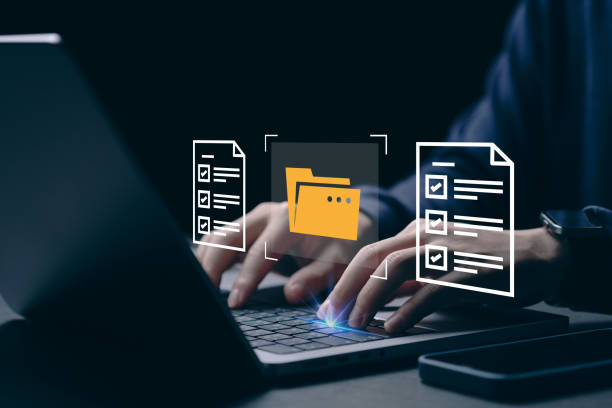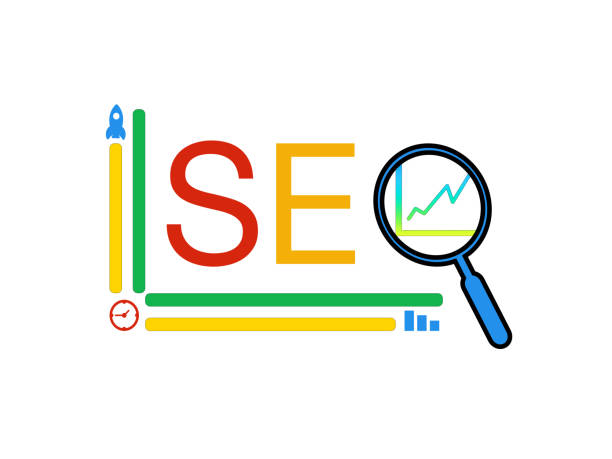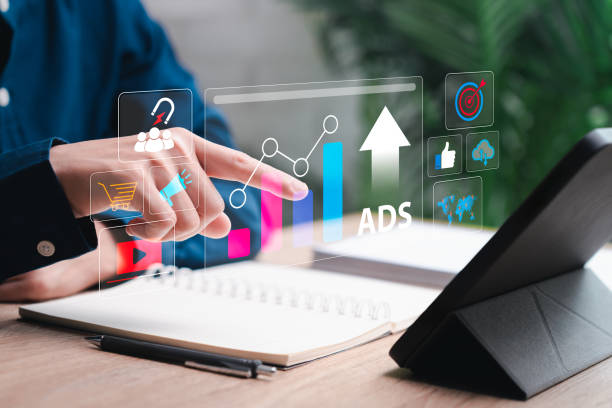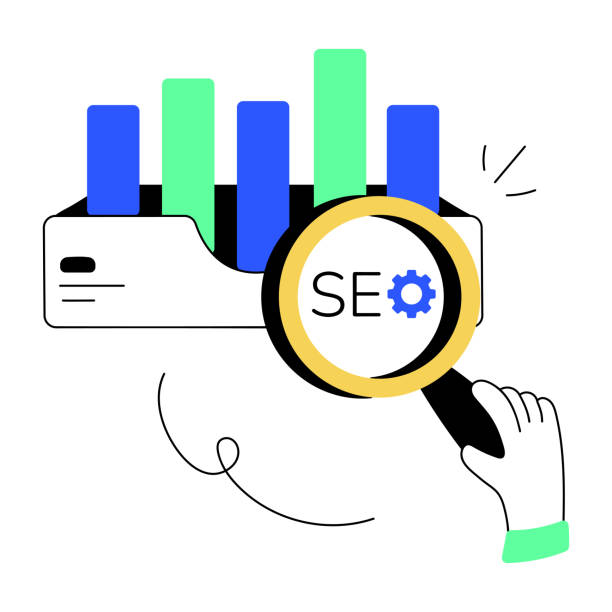What is On-Page SEO and Why Does it Matter?
On-Page SEO refers to a set of actions taken within a website to improve its ranking in search engines like Google.
These actions include optimizing content, using appropriate keywords, improving site structure, and increasing page loading speed.
The importance of on-page SEO lies in the fact that it helps search engines better understand the site’s content, thereby increasing the site’s ranking in search results.
As a fundamental pillar of SEO, on-page SEO plays a vital role in attracting organic traffic and increasing visitors.
By implementing appropriate optimizations within the site, one can significantly improve the site’s ranking and, as a result, attract more customers.
Paying attention to on-page SEO is a long-term investment that brings positive results for businesses.
Technical SEO principles also fall under the umbrella of on-page SEO and play a crucial role in improving website performance and increasing search engine rankings.
These principles include optimizing site loading speed, creating a suitable URL structure, using title and meta description tags, and optimizing images.
By following technical SEO principles, you can ensure that the website is easily accessible and reviewable by search engines, thereby improving the site’s ranking in search results.
Optimizing site loading speed is one of the most important factors in technical SEO because internet users tend to access the information they need quickly, and if a website takes too long to load, the likelihood of users leaving the site increases.
In summary, on-page SEO is a set of activities that helps you optimize your site’s content in a way that is attractive to search engines and allows you to achieve a higher ranking in search results.
This, in turn, leads to increased site traffic and the attraction of more audiences.
Performing on-page SEO optimization helps increase conversion rates and improve user experience.
Are you losing potential customers due to an unprofessional website? Rasaweb is your answer! With our specialized corporate website design services:
✅ Enhance the credibility and position of your business
✅ Experience attracting more targeted customers
⚡ Act now to receive a free consultation!
Keyword Research for On-Page SEO
Keyword research is one of the most important steps in on-page SEO.
Choosing the right keywords helps you optimize your site’s content in a way that is appealing to your target audience and search engines.
For keyword research, you can use various tools such as Google Keyword Planner, Ahrefs, and SEMrush.
These tools provide you with information about search volume, competition, and related keywords.
When choosing keywords, pay attention to two things: first, the keywords should be relevant to your site’s content, and second, they should have a good search volume.
Also, use long-tail keywords, as these keywords usually have less competition and can attract more targeted traffic to your site.
Using appropriate keywords in page titles, meta descriptions, heading tags, and the main text of the content is one of the most important on-page SEO techniques.
By conducting thorough research and selecting appropriate keywords, you can improve your site’s ranking in search results and attract more audiences.
Click here to preview your posts with PRO themes ››
Using keywords related to your industry and services is also very important.
For example, if you have an online clothing store, you can use keywords such as “online shopping for women’s clothing,” “online shopping for men’s clothing,” and “shopping for children’s clothing.”
However, remember that excessive use of keywords (Keyword Stuffing) can have a negative impact on your site’s ranking.
It is best to use keywords naturally in the text of the content and avoid creating unnatural and keyword-filled texts.
On-page SEO helps you have a stronger online presence.
In summary, keyword research is an ongoing process that requires constant review and updating.
Given the changes in user behavior and search engine algorithms, you should regularly review your keywords and, if necessary, make the necessary changes.
This process helps you always stay one step ahead of the competition and maintain your site’s ranking in search results.
Keyword research tools are very helpful.
Content Optimization for On-Page SEO
Content optimization is one of the most important aspects of on-page SEO.
High-quality, engaging, and relevant content is not only valuable to users but also helps search engines better understand your site’s content.
To optimize content, you must first ensure that your content is unique and non-repetitive.
Using duplicate content can have a negative impact on your site’s ranking.
Second, your content should fully and comprehensively address the topic and provide sufficient information to users.
Third, your content should be organized in a way that is easy for users to read and understand.
Using titles, subtitles, paragraphs, and lists helps improve content readability.
Fourth, using relevant images and videos can increase the appeal of the content and keep users on your site longer.
Using keywords in content is also very important, but you should use them naturally and without creating unnatural texts.
Also, optimizing images using ALT tags and appropriate file names can help improve image SEO.
Also, use relevant internal and external links in your content.
Internal links help improve site structure and guide users, while external links help increase your site’s credibility.
Doing content SEO ensures that your content is displayed in higher rankings in search results and attracts more traffic to your site.
On-page SEO helps you optimize your content.
Click here to preview your posts with PRO themes ››
In summary, content optimization is an ongoing process that requires constant review and updating.
Given the changes in user behavior and search engine algorithms, you should regularly review your content and, if necessary, make the necessary changes.
This process helps you always provide high-quality and relevant content to users and maintain your site’s ranking in search results.
On-page SEO is very important for increasing traffic.
| Element | Description |
|---|---|
| Page Title | The page title should be attractive and relevant to the content. |
| Meta Description | The meta description should be a summary of the page’s content. |
| Heading Tags | Heading tags (H1-H6) should specify the structure of the content. |
| Main Text | The main text should be of good quality and relevant to the topic. |
| Images | Images should be optimized with ALT tags and appropriate file names. |
Suitable URL Structure for On-Page SEO
A suitable URL structure is an important aspect of on-page SEO that can significantly impact your site’s ranking in search results.
A good URL should be short, readable, and relevant to the content of the page.
Avoid using long and complex URLs that contain incomprehensible letters and numbers.
Instead, use keywords related to the content in the URL.
For example, if your page is about “Laptop Buying Guide,” a suitable URL could be “/laptop-buying-guide/”.
Using hyphens (-) instead of underscores (_) in URLs is recommended because search engines consider hyphens as word separators, while underscores are considered a single character.
Also, avoid using uppercase letters in URLs, as this may cause problems in some systems.
Try to design your site’s URL structure in a way that is understandable to users and search engines.
For example, you can use logical categories to organize URLs.
In summary, a suitable URL structure is an important factor in website optimization that can help improve your site’s ranking in search results.
By following the principles of a suitable URL structure, you can ensure that search engines can easily identify and rank your site’s pages.
Also, a suitable URL can help users easily understand what the page’s content is about.
On-page SEO with a suitable URL structure improves user experience.
Remember that changing existing URL structures can have a negative impact on your site’s ranking, so before making any changes, make sure you set up a 301 redirect to transfer traffic from the old URLs to the new URLs.
By doing this, you can avoid losing traffic and site ranking.
On-page SEO is essential for improving site performance.
Are you worried that your company’s old website is scaring away new customers? Rasaweb solves this problem with modern and efficient corporate website design!
✅ Increases the credibility of your brand.
✅ Helps to attract targeted customers.
⚡ Contact Rasaweb for a free consultation!
Image Optimization for On-Page SEO
Image optimization is another important aspect of on-page SEO that is often overlooked.
High-quality and optimized images can increase the appeal of content and help improve your site’s ranking in search results.
To optimize images, you must first reduce the file size of the images.
High-volume images can slow down page loading speeds and create an unfavorable user experience.
Use image compression tools to reduce the file size of images without reducing their quality.
Second, use ALT tags to describe the images.
ALT tags help search engines understand the content of the images.
Use keywords related to the page’s content in ALT tags.
Third, use an appropriate file name for the images.
The file name of the images should be related to the image content and include keywords.
For example, if your image is about “Laptop Buying Guide,” a suitable file name could be “laptop-buying-guide.jpg”.
In summary, image optimization is an important factor in on-page SEO that can help improve page loading speed, user experience, and your site’s ranking in search results.
By following the principles of image optimization, you can ensure that your images are fully accessible to search engines and help improve your site’s performance.
On-page SEO with optimized images attracts more audiences.
Paying attention to image SEO in on-page SEO is very important.
Also, use an appropriate format for the images.
JPEG, PNG, and WebP are among the common formats for images.
The JPEG format is suitable for images with many colors, while the PNG format is suitable for images with few colors and transparency.
The WebP format is a newer format that can significantly reduce the file size of images while maintaining their quality.
Choosing the right format for images can have a significant impact on page loading speed.
On-page SEO helps you optimize your images.
Optimizing Site Loading Speed for On-Page SEO
Optimizing site loading speed is one of the most important factors in on-page SEO that can directly impact user experience and your site’s ranking in search results.
Internet users tend to access the information they need quickly, and if a website takes too long to load, the likelihood of users leaving the site increases.
Search engines also consider site loading speed as one of the ranking factors.
To optimize site loading speed, you can use various techniques such as file compression, using a CDN (Content Delivery Network), optimizing images, reducing the number of HTTP requests, and using Cache.
You can also use site speed testing tools such as Google PageSpeed Insights and GTmetrix to identify speed problems on your site and apply the suggested solutions to improve your site loading speed.
Optimizing site loading speed requires careful analysis and the use of appropriate tools.
On-page SEO helps you improve your site speed.
Optimizing site speed not only helps improve the site’s ranking in search results but also improves user experience and increases conversion rates.
Users who have a good experience visiting your site are more likely to return to your site and use your services or products.
On-page SEO with high loading speed helps increase user satisfaction.
In summary, optimizing site loading speed is an ongoing process that requires constant review and updating.
Given the changes in technology and user behavior, you should regularly check your site’s speed and, if necessary, make the necessary changes.
This process helps you always have a fast and efficient site and maintain your site’s ranking in search results.
On-page SEO requires high loading speed.
Internal and External Linking for On-Page SEO
Internal and external linking is an important aspect of on-page SEO that can help improve site structure, increase credibility, and your site’s ranking in search results.
Internal linking means creating links between different pages of your site.
This helps search engines better understand your site structure and easily find different pages of your site.
Also, internal linking helps users easily navigate your site and find the information they need.
When internal linking, use keywords related to the content of the destination page in the link text.
External linking means receiving links from other sites to your site.
This helps increase your site’s credibility with search engines.
Try to get links from reputable and relevant sites in your field.
Links received from unreliable and low-quality sites can have a negative impact on your site’s ranking.
On-page SEO requires an appropriate linking strategy.
| Link Type | Benefits | Important Tips |
|---|---|---|
| Internal | Improve site structure and guide users | Use related keywords |
| External | Increase site credibility | Get links from reputable sites |
In summary, internal and external linking is an ongoing process that requires careful planning and execution.
By creating high-quality and relevant links, you can help improve site structure, increase credibility, and your site’s ranking in search results.
On-page SEO with appropriate linking increases traffic.
The linking strategy in on-page SEO is very important.
On-page SEO with high-quality links increases site credibility.
Using Structured Data (Schema Markup) for On-Page SEO
Using structured data (Schema Markup) is an advanced on-page SEO technique that can help search engines better understand your site’s content and display more accurate information in search results.
Structured data is code that is added to your site’s pages and provides information about the content type, author, publication date, ratings, and other content-related details to search engines.
By using structured data, you can create more attractive and informative search results for users and increase your site’s click-through rate (CTR).
There are different types of structured data that you can use depending on the type of content on your site.
For example, you can use structured data for news articles, cooking recipes, events, products, and other types of content.
Using structured data in on-page SEO can be very effective.
On-page SEO with structured data improves display in search results.
Using structured data requires technical knowledge, but with the available tools, you can easily add this code to your site’s pages.
You can also use the Google Rich Results Test tool to check the validity of your structured data.
In summary, using structured data is an effective way to improve your site’s on-page SEO, which can help increase your site’s ranking in search results and attract more traffic.
On-page SEO using Schema Markup increases click-through rate.
Remember that using structured data alone is not enough and should be used in conjunction with other on-page SEO techniques such as content optimization, keyword research, and linking to achieve better results.
On-page SEO requires a combination of different techniques.
Are you tired of your online store website not generating as much revenue as its potential? Rasaweb, a specialist in designing professional online store websites, solves this problem once and for all!
✅ Increase sales rates and revenue
✅ High loading speed and unparalleled user experience
⚡ Get a free online store website design consultation
Mobile Optimization for On-Page SEO
Mobile optimization is a critical aspect of on-page SEO, as most internet users today access websites through mobile devices.
If your website is not optimized for mobile, you will create an unfavorable user experience for users and your site’s ranking in search results will decrease.
To optimize for mobile, you must first use a Responsive Design.
Responsive design means that your website automatically adapts to the screen size of different devices.
Second, optimize your site loading speed on mobile devices.
Mobile users expect websites to load quickly, and if a website takes too long to load, the likelihood of users leaving the site increases.
Third, use large and readable fonts and buttons so that users can easily interact with your website.
On-page SEO with mobile optimization increases user satisfaction.
Google has implemented mobile-first indexing since 2019, meaning that the mobile version of your website is considered the primary version for ranking.
Therefore, if the mobile version of your website is not optimized, your site’s ranking in search results will decrease.
On-page SEO requires responsive design.
In summary, mobile optimization is an ongoing process that requires constant review and updating.
Given the changes in technology and user behavior, you should regularly check your website for mobile and, if necessary, make the necessary changes.
This process helps you always have a mobile-friendly website and maintain your site’s ranking in search results.
On-page SEO is very important for mobile users.
Continuous Review and Improvement of On-Page SEO
Continuous review and improvement of on-page SEO is an ongoing process that is essential to maintain and improve your site’s ranking in search results.
SEO is not a one-time process and must be regularly reviewed and updated to keep pace with changes in search engine algorithms and user behavior.
To review and continuously improve on-page SEO, you can use various tools such as Google Analytics, Google Search Console, and other SEO tools.
With Google Analytics, you can check your site’s traffic and get information about user behavior on your site.
With Google Search Console, you can check your site’s performance in search results and identify problems such as Crawl errors, index problems, and mobile problems.
By conducting these reviews regularly, you can improve your site’s on-page SEO.
In summary, continuous review and improvement of on-page SEO is an essential process that helps you always have an optimized site and maintain your site’s ranking in search results.
On-page SEO is a long-term investment that will bring positive results for your business.
You should continuously strive to improve your site’s on-page SEO and stay ahead of your competitors.
To be successful in on-page SEO, you must be patient and persistent.
Doing on-page SEO continuously can grow your business.
Reviewing and analyzing on-page SEO is very important.
By continuously reviewing and improving on-page SEO, you can take advantage of new opportunities to improve your site’s ranking and attract more traffic to your site.
Remember that SEO is a constant competition and you must always be learning and improving to win this competition.
On-page SEO helps you get seen in search results.
Frequently Asked Questions
| Number | Question | Answer |
|---|---|---|
| 1 | What is On-Page SEO? | On-Page SEO refers to a set of actions taken within a website to optimize its pages in order to achieve a better ranking in search results. |
| 2 | What is the most important factor in On-Page SEO? | High-quality, relevant, and comprehensive content that meets the user’s needs is the most important factor in On-Page SEO. |
| 3 | What role does the Title Tag play in On-Page SEO? | The Title Tag is one of the most important factors that tell search engines and users what the page’s content is about. It should include the main keyword and be attractive. |
| 4 | How important is the Meta Description Tag? | Although it does not directly affect ranking, it is very effective on the click-through rate (CTR) in search results and encourages users to visit the page. |
| 5 | How is image optimization done in On-Page SEO? | By using appropriate alt tags, compressing the image size to increase loading speed, and using a meaningful file name. |
| 6 | What is the importance of using Headings (H1, H2, H3) in On-Page SEO? | Headings help structure content, increase readability, and help search engines understand the hierarchy and subtopics of the content. |
| 7 | What does Internal Linking mean and what are its benefits? | Internal linking means creating links between different pages of a website. This helps distribute authority, improve user navigation, and help search engine crawling. |
| 8 | Where should the Focus Keyword be placed on the page? | The focus keyword should be in the title tag, meta description, H1, first paragraph, and naturally throughout the text and, if possible, in the URL address. |
| 9 | What effect does copied or duplicate content have on On-Page SEO? | Duplicate content can harm site ranking and confuse search engines as to which version is original and may detect it as spam. |
| 10 | How important is page loading speed in On-Page SEO? | Page loading speed is an important ranking factor and directly affects user experience. Slow pages increase user bounce rates. |
And other services of Rasa Web advertising agency in the field of advertising
Smart Content Strategy: A novel service to increase user engagement through the use of real data.
Smart Reportage: A novel service to increase customer attraction through marketing automation.
Smart Content Strategy: Designed for businesses looking to manage campaigns through the use of real data.
Smart Linking: A fast and efficient solution for attracting customers with a focus on marketing automation.
Smart Custom Software: Transform customer behavior analysis with the help of marketing automation.
And more than hundreds of other services in the field of internet advertising, advertising consulting, and organizational solutions
Internet Advertising | Advertising Strategy | Advertorial Report
Sources
? Transform your business in the digital world with Rasaweb Afrin. By providing comprehensive digital marketing services, including custom website design, we help you shine in today’s competitive market and achieve your goals.
📍 Tehran, Mirdamad Street, next to the Central Bank, Kazeroon South Alley, Ramin Alley No. 6
“`












